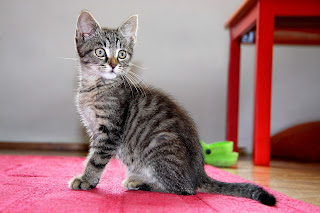You have adopted a new cat, it is wonderful news as you have saved a cats life. Your life will now be filled with happiness and many smiles as owning a cat can be great fun.
Before the fun and bonding period begins with your new cat there will be a period of adjustments.
The adjustment period will last about a week and will allow your new cat to get acclimated to their new home, family members and other pets. Follow these six steps to get your home and your family ready for your new cat.
Step 1
Plan a family meeting to make sure that everyone understands the new cat house rules. Your new cat will need time to get use to their new family and thus picking up, playing and distracting the cat is not wise. Everyone should let the cat be and allow the cat to make the first move. When the cat comes to you then pet them and talk to the new cat softly.
Step 2
Buy cat products; litter box, natural pine litter, stainless steel or ceramic food and water bowls, buy the same food that the cat has been eating and slowly mix in the new canned food. Slowly wean them off their food so they do not get a stomach ache.
You will also need sisal scratching post, catnip, cat toys, cat tree, cat bed, cat brush, comb, cat shampoo, dander wipes and nail clipper. Another product I recommend is Feliway room diffuser, comfort zone and spray mood modifier. For best prices on these items I recommend Chewy pet supplies at chewy.com
Step 3
Make the transition period easier on the new cat with Feliway room diffusers and spray modifier. Plug the diffuser into your electrical outlet the formula will stimulate your cat’s natural pheromones to help the cat cope with the stress of a new home. Spray carrier with mood modification by Feliway to help keep your new cat calm while being transported to your home
Step 4
Get your home ready for your new cat by getting down on your knees and looking at the hard surface floor or carpet for things that your cat may pick up, chew or swallow. Look for safety pins, paper clips, nails, push pins, coins, small children's toys, paper, Styrofoam peanuts, pens, markers or pencils.
Examine the floor closely for anything that may be harmful to your cat. Remove medications from the counter and put in a cabinet. Cleaning supplies and pesticides should be put away so the cat cannot investigate.
Step 5
Cats like to play with extension cords, lamp cords and loose wires. I had a feral kitten that was fascinated with the printer wires. He got hung up in them and I needed to act fast to free him.
Loose wires are dangerous when it comes to a cat as they can quickly become tangled. Run all ground level extension cords, or electronic wires through PVC pipes. Put child safety caps on all electrical outlets.
Step 6
Set up a safe room for your new cat. This room should be away from human traffic and other pets.
For all new cats that come into my home I put them in an emptied out walk in closet. It is the perfect size for a cat safe room. With light overhead, there is ample space for the new cats needs. Plus the space between the door and the floor allows the new cat to smell the scent of the home, get used to the noises and sniff other pets.
Here is a set that I designed to show one of my adopters what a cat-safe room would look like. I designed this set from products I found at chewy.com, polyvore.com Walmart.com, and Target.com
Furry Friends: Cat Safe/Play Room
If you do not have a spare room for your cat then buy a large cat cage. The crate should have enough room for a litter box, food and water bowls and a cat bed. Amazon.com has a good sized cat cage that is approximately five feet tall, five kittens are comfortable and 2-3 small cats can reside in this cage in comfort.
The room or cage will become the cats’ safe room.
The new cat should stay in the safe room for 5 days. Family members should visit with the cat. They may talk to the cat softly and allow the cat to come to them to be petted.
Tips:
Set up a daily routine; feed your cat at the same time, groom them and play with them. By doing this the cat will bond with you and will learn to depend on you.
Buy the cat a breakaway collar and identification tag. If your cat is an indoor/outdoor cat then get microchip identification. Your veterinarian will surgically implant the microchip ID under the cat’s skin. If your cat is lost and a breakaway collar is gone. Your cat may be picked up by animal control and taken to a shelter. The cat will be scanned for the microchip and you will be reunited with your pet.
Here is an identification tag that I designed. I like it because of the bright colors and also because there is room for all of your pet's information.
Make an appointment for a new pet check-up with your veterinarian. If you have other cats it is best that your new cat go to veterinarian’s office before allowing cats to come in contact with each other.
Related Cat Adoption Guide Posts by Sgolis





